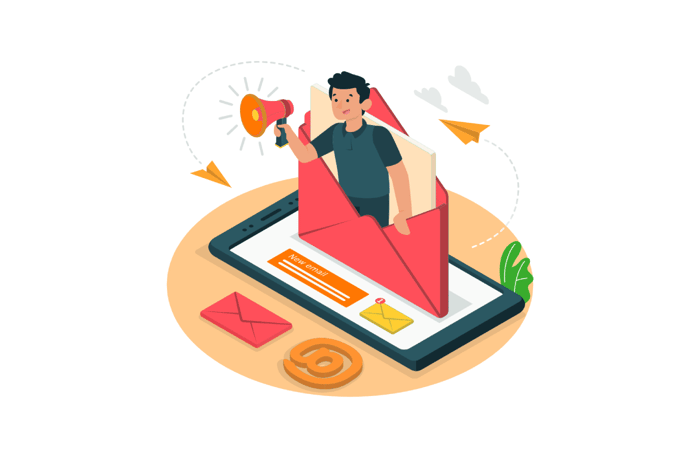
Personalize your emails by using the recipient's name in the subject line and body of the email.
One effective way to make sure your emails stand out and are read is by personalizing them. Including the recipient's name in both the subject line and body of your email shows that you have taken the time and effort to address this particular recipient personally. Doing this also builds stronger relationships between colleagues, clients, and customers, as they feel acknowledged and valued. By personalizing emails in this way, recipients view this as a sign of respect, conveying professionalism with every message sent.
Segment your email list based on interests or demographics to send targeted messages.
Segmenting your email list has become increasingly popular in recent years, as it allows you to tailor the content of your emails to specific groups. This can help to more effectively engage with members of your audience, as sends that hold personal relevance tend to produce higher open and clickthrough rates. This process requires data collection on the characteristics of individual subscribers. You might consider segmenting your list according to interests and demographics so that you can send messages which are relevant to each group. This approach also allows you to A/B test different subject lines and assess how they perform within each unique segment. Segmenting your email list is a great way to ensure that every send is targeted, personalized, and optimized for maximum engagement with the right people.
Use A/B testing to determine the most effective subject lines, calls to action, and content for your emails.
A/B testing is an important tool for businesses that rely on email campaigns to generate leads and conversions. By creating two versions of an email, A/B testing allows marketers to compare the performance of different subject lines, calls to action, and content, in order to determine what combination will work best with their target audience. This method allows marketers to gather detailed information about how customers are responding to their emails, enabling them to make informed decisions as they refine their email strategies. By using A/B testing today, you can create email campaigns that lead directly to more conversions tomorrow.
Incorporate social media buttons and links to your email campaigns to encourage sharing.
Incorporating social media buttons and links into your email campaigns is a great way to get the attention of recipients and increase engagement. By giving recipients easy access to share information through their own networks, email campaigns become more effective in reaching the right people, while also giving you an opportunity to build relationships by extending your social reach. When leveraging this strategy, you'll be able to target audiences on various platforms and collect actionable data that you can use to gauge customer behavior better and refine future campaigns accordingly. In essence, incorporating social sharing into your emails will bring extra value to both you and your customers.
Make sure your emails are mobile-friendly, as many people read their emails on their smartphones.
In today's digital age, having an understanding of mobile-friendly design and how it applies to emails is essential. An increasingly large percentage of people read emails on their smartphones and those who don't may still appreciate the convenience a mobile-friendly format provides. Therefore, tailoring your emails for a smooth, seamless transition from desktop or laptop to mobile is a useful way to ensure that you always have the upper hand in communication. Additionally, for emails beyond just plain text, always remember to check and double-check your work on all possible devices before sending, so as to maximize readability and clarity regardless of device choice.
Use compelling subject lines and preview text to grab the reader's attention.
Crafting an effective subject line goes a long way toward grabbing the attention of potential readers. Put some thought into your subject, making sure it is catchy and captivating, but also relevant to the content inside. For example, use action words such as “discover” or “unlock” to get people excited about what could be waiting for them. It is also important to take advantage of the preview text, which often directly follows a subject line in many email services. By being strategic with this content, you can provide more detail on what readers can expect when they open your message. Being intentional about these elements will ensure that eyes are drawn to your message and curious enough to click through.
Use images and graphics to make your emails more visually appealing, but be sure to also include relevant text.
Using images and graphics in emails can be a great way to draw your reader’s attention and make your message more visually appealing. When incorporating these elements into your emails, it is important to ensure they are relevant to the message you want to convey and not simply used as decoration. While visuals can help you break up text and add variety to your email, including supporting text will help you get your point across more effectively by providing contextual information and background on the subject matter. By striking the right balance between images and written details, you can create a truly memorable email experience for your readers that drives engagement and loyalty.
Include calls to action, such as "Learn More," "Sign Up," or "Buy Now," to encourage readers to take a specific action.
When seeking to drive action from your readers, it is important to include calls to action. These can range from a more generalized language such as "Learn More" or "Find Out," to more specific phrases such as "Sign Up" or "Buy Now." Calls to action should be clear and concise, as well as relevant to the content of the page. Doing so will give visitors a clear sense of understanding, while also encouraging their engagement with your brand's message. Ensure that you always provide options for visitors who don't feel ready to commit — those phrases might include "Browse Our Products" or even simply "Explore."
Use automation to send personalized, trigger-based emails based on the recipient's actions or inactivity.
Implementing automation for sending emails based on the user's actions or inactivity can be a valuable addition to an email marketing campaign. It allows businesses to create seamless customer experiences, increase engagement with potential customers, and foster greater loyalty from existing customers. Automated emails can be used to send customized messages as soon as an event occurs or when a customer has been inactive for a certain period of time; potentially bringing them back into the fold with personalized offers, relevant content, and promos that show you understand their behaviors. Automated emails also enable businesses to reach their audience on their own terms and provide added convenience by providing information when it’s most needed.
Utilize email analytics to track the success of your campaigns and make data-driven decisions for future emails.
In order to ensure that your email campaigns are successful and are reaching as many people as possible, it is vital to use email analytics. By collecting data on open and click rates, email analytics can help you track the performance of each campaign and make decisions for future emails based on this insight. With this kind of data at your fingertips, you can determine which content resonates with your audience and how best to optimize future campaigns for maximum success. Email analytics just provides the evidence you need in order to take your campaigns to the next level.

